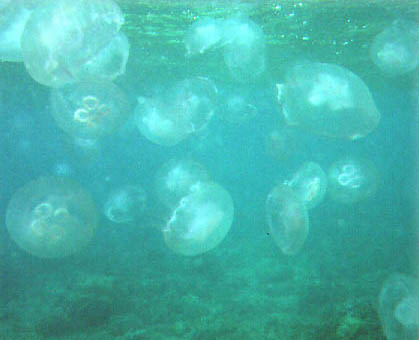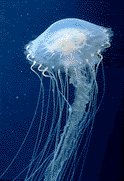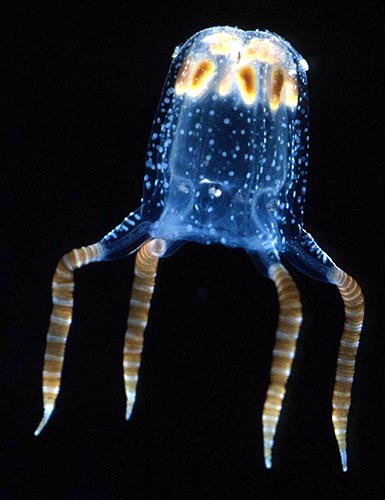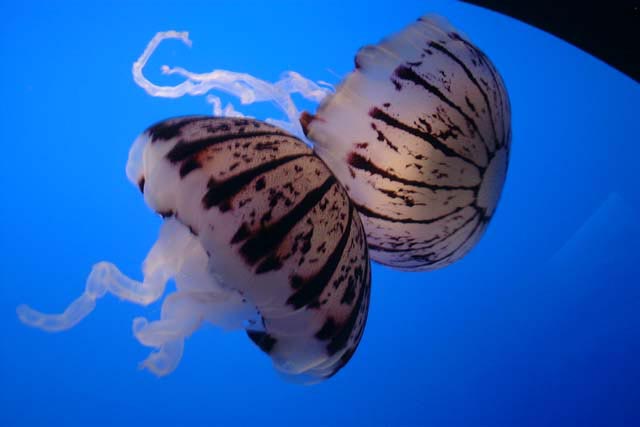HOME
ANIMALS
SEA LIFE
Jellyfish
 Jellyfish
is the common name for any of the invertebrate animals making up two
classes of the coelenterate phylum. About 2700 hydrozoan and 200
scyphozoan species are known. The term jellyfish applies more
specifically to the free-swimming, gelatinous organism called the
medusa, the form usually taken during the sexual stage of these
animals, this generation alternating with a bottom-dwelling polyp
stage in which reproduction is asexual. In one class the medusae tend
to be small and the polyps well developed, whereas in the other class
the medusae predominate. Both classes are marine, except for a few
hydrozoans, such as Hydra, that live in fresh water.
Jellyfish
is the common name for any of the invertebrate animals making up two
classes of the coelenterate phylum. About 2700 hydrozoan and 200
scyphozoan species are known. The term jellyfish applies more
specifically to the free-swimming, gelatinous organism called the
medusa, the form usually taken during the sexual stage of these
animals, this generation alternating with a bottom-dwelling polyp
stage in which reproduction is asexual. In one class the medusae tend
to be small and the polyps well developed, whereas in the other class
the medusae predominate. Both classes are marine, except for a few
hydrozoans, such as Hydra, that live in fresh water.
STRUCTURE AND BEHAVIOR
 As
in other coelenterates, the jellyfish has only two major
developmental layers (ectoderm and endoderm), no head, a gut but
no anus, and a nervous system without a brain. The body exhibits
radial symmetry, or symmetry about an axis. Prey are usually taken
with tentacles bearing nematocysts, or stinging cells. The polyps
commonly live on the sea bottom and produce other polyps by asexual
reproduction. Hydrozoan polyps generally form colonies, with
different kinds of polyps specialized for such functions as
reproduction and feeding. The polyps usually bud off medusae.
As
in other coelenterates, the jellyfish has only two major
developmental layers (ectoderm and endoderm), no head, a gut but
no anus, and a nervous system without a brain. The body exhibits
radial symmetry, or symmetry about an axis. Prey are usually taken
with tentacles bearing nematocysts, or stinging cells. The polyps
commonly live on the sea bottom and produce other polyps by asexual
reproduction. Hydrozoan polyps generally form colonies, with
different kinds of polyps specialized for such functions as
reproduction and feeding. The polyps usually bud off medusae.
Ordinarily, the medusae produce eggs and sperm that unite and give
rise to a new generation of polyps. The medusae are bell shaped and
swim  by
contraction of muscles around the rim. Their behavior is simple.
Most swim slowly and are transported by currents. Transparency
results partly from the fact that a jellyfish body contains less
than 1 percent organic matter-the rest is water. Large jellyfish
are up to 2 m (6.6 ft) wide.
by
contraction of muscles around the rim. Their behavior is simple.
Most swim slowly and are transported by currents. Transparency
results partly from the fact that a jellyfish body contains less
than 1 percent organic matter-the rest is water. Large jellyfish
are up to 2 m (6.6 ft) wide.
Jellyfish have little nutritional value. Their stings can be
painful, and a few tropical forms can be deadly to humans.
Contributed By:
Michael T. Ghiselin
Scientific classification: Jellyfish make up the classes Hydrozoa,
with well-developed polyps, and Scyphozoa, in which medusae
predominate, of the phylum Coelenterata (or Cnidaria).
"Jellyfish," Microsoft® Encarta® Encyclopedia 99.
© 1993-1998 Microsoft Corporation. All rights reserved.

 Jellyfish
is the common name for any of the invertebrate animals making up two
classes of the coelenterate phylum. About 2700 hydrozoan and 200
scyphozoan species are known. The term jellyfish applies more
specifically to the free-swimming, gelatinous organism called the
medusa, the form usually taken during the sexual stage of these
animals, this generation alternating with a bottom-dwelling polyp
stage in which reproduction is asexual. In one class the medusae tend
to be small and the polyps well developed, whereas in the other class
the medusae predominate. Both classes are marine, except for a few
hydrozoans, such as Hydra, that live in fresh water.
Jellyfish
is the common name for any of the invertebrate animals making up two
classes of the coelenterate phylum. About 2700 hydrozoan and 200
scyphozoan species are known. The term jellyfish applies more
specifically to the free-swimming, gelatinous organism called the
medusa, the form usually taken during the sexual stage of these
animals, this generation alternating with a bottom-dwelling polyp
stage in which reproduction is asexual. In one class the medusae tend
to be small and the polyps well developed, whereas in the other class
the medusae predominate. Both classes are marine, except for a few
hydrozoans, such as Hydra, that live in fresh water. As
in other coelenterates, the jellyfish has only two major
developmental layers (ectoderm and endoderm), no head, a gut but
no anus, and a nervous system without a brain. The body exhibits
radial symmetry, or symmetry about an axis. Prey are usually taken
with tentacles bearing nematocysts, or stinging cells. The polyps
commonly live on the sea bottom and produce other polyps by asexual
reproduction. Hydrozoan polyps generally form colonies, with
different kinds of polyps specialized for such functions as
reproduction and feeding. The polyps usually bud off medusae.
As
in other coelenterates, the jellyfish has only two major
developmental layers (ectoderm and endoderm), no head, a gut but
no anus, and a nervous system without a brain. The body exhibits
radial symmetry, or symmetry about an axis. Prey are usually taken
with tentacles bearing nematocysts, or stinging cells. The polyps
commonly live on the sea bottom and produce other polyps by asexual
reproduction. Hydrozoan polyps generally form colonies, with
different kinds of polyps specialized for such functions as
reproduction and feeding. The polyps usually bud off medusae. by
contraction of muscles around the rim. Their behavior is simple.
Most swim slowly and are transported by currents. Transparency
results partly from the fact that a jellyfish body contains less
than 1 percent organic matter-the rest is water. Large jellyfish
are up to 2 m (6.6 ft) wide.
by
contraction of muscles around the rim. Their behavior is simple.
Most swim slowly and are transported by currents. Transparency
results partly from the fact that a jellyfish body contains less
than 1 percent organic matter-the rest is water. Large jellyfish
are up to 2 m (6.6 ft) wide.